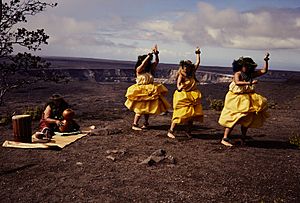Traditional Hawaiian games facts for kids

Pāʻani Hawaiʻi (Hawaiian: Pāʻani Hawaiʻi) are traditional Hawaiian games and contests. The word pāʻani is also used as a shorter name. Most of these games include Hawaiian language and chanting.
One special game is lele koali. This is a Hawaiian swinging game. It uses either a koali vine or a koali hao (metal chain). During lele koali, people gather for days or even a week. They socialize, tell stories, play music, and share meals.
Contents
History of Hawaiian Games
Why Games Declined
In the early 1900s, many traditional Hawaiian games, called pāʻani kahiko, became less common. This happened as Hawaiian cultural practices changed. One reason was a decrease in the native Hawaiian population.
Also, new religious beliefs, like Christianity, made it hard for some Hawaiians to keep their old customs. The Hawaiian government was also overthrown. This led to the Hawaiian language being banned in schools. These changes took attention away from pāʻani. Many games were linked to akua, which are Hawaiian gods and goddesses. So, these games were sometimes put aside.
First Comeback of Games
The pāʻani started to become popular again in the 1950s. This was partly thanks to a special show in 1921. It was put on by the Honolulu Parks and Recreation Department. President Woodrow Wilson visited Hawaii and saw the show. He said that more should be done to support Pāʻani Hawaiʻi Kāhiko. This led to more money being put into these shows. They were even performed competitively at the University of Hawaiʻi at Mānoa.
Second Comeback of Games
Another big comeback happened when the ʻAha Pūnana Leo schools were started. These schools focused on teaching in ʻōlelo Hawaiʻi (the Hawaiian language). They made it normal for Hawaiian practices to be part of daily life. In the 1990s, many students in these schools played lots of pāʻani.
Here are some examples of games that became popular again:
- Pala ʻIe: This game is like the Japanese kendama. It uses a flexible stick made of braided coconut leaves. It has a loop at one end and a tapa ball on a string. The goal is to catch the ball in the loop.
- Peʻepeʻe akua: This is like hide-and-seek. It was played with a chant for Pele, a Hawaiian goddess.
- Lono, mauli, pau: This game is similar to rock-paper-scissors. It helped players learn the different phases of the moon. This game was often played during Makahiki festivals.
Many pāʻani Hawaiʻi are connected to the Makahiki festival. Hawaiians believed there were many akua, or gods and goddesses.
Makahiki Games
Makahiki Games are the most common traditional games in Hawaii. They are played when the Makaliʻi (Pleiades) star cluster rises. This happens during the month of Welehu.
Some popular Makahiki games include:
- ʻUlu maika: Players bowl a rounded stone between two sticks.
- Mokomoko (also called kuʻikuʻi): This is a boxing contest. It includes special chants for the place where it is played.
- Hākōkō: Hawaiian wrestling.
- ʻŌʻō ʻIhe: Spear throwing, usually at a banana stump.
- Honuhonu: A game where players pull each other's hands.
- Keʻa Pua: Dart throwing.
- (Pā) Uma: Wrist wrestling.
- Pūhenehene: A game of hiding stones.
- Kākālāʻau: Spear fencing.
- Loulou: Players interlock their fingers and pull.
- Kulakulaʻi: A pushing contest.
Some old stories, called moʻolelo, say that mokomoko was the first game played during Makahiki. It sometimes required blood to be drawn. During the Makahiki games, the champion of each ahupuaʻa (a land division) could travel around the island. They would be with other champions. An akua pāʻani, which was an idol related to play, would travel with them. This idol would watch over the players. This was a special event, as ordinary people usually did not get to interact with their aliʻi (chiefs or chiefesses) in this way.
Games for Fun
Some pāʻani were played just for leʻaleʻa (fun) and hoʻoipoipo (courting). These games were often more complex.
- Kilu: This was a courting game for aliʻi (chiefs). It involved hula (dance) and mele (songs). It also helped show a person's family history.
- ʻUme: Similar to Kilu, but for common people. It was called ʻume because players were "drawn" to each other.
- Pūhene: A game of hiding a rock on a person's body.
These games, like Hiʻiaka's experiences with Kilu and Pūhenehene, show how important language and movement were in pāʻani.
Other Hawaiian Games
Many other pāʻani exist in Hawaii. Language is often a very important part of them. Some games are specific to one place, like hoʻolele kī from Kīlauea. Others are only played in certain regions. For example, kaupua is a race done in the ocean. Keʻa pua needs a sugar cane stalk, a sugar cane flower, a dirt mound, and rope.
One of the most famous games is kōnane. This is a game of wits. It uses ʻiliʻili (small stones) from the ocean and pōhaku (larger rocks) from plains or mountains. You can find out more about these games in books like Donald D. Kilolani Mitchell's Hawaiian games for today and Pukui's Hawaiian Dictionary.
Images for kids


